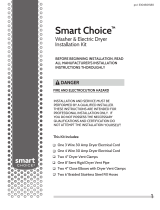
1
TABLE OF CONTENTS
IMPORTANT SAFETY INSTRUCTIONS ................................................................. 2
Gas Dryer Precautions .................................................................................................. 3
General Safety Precautions .......................................................................................... 4
PARTS AND FEATURES ....................................................................................... 5
INSTALLATION INSTRUCTIONS ..........................................................................6
Tools Needed .................................................................................................................6
Additional Parts Required ..............................................................................................7
Location Requirements .................................................................................................7
Electrical & Gas Supply Requirements .......................................................................... 9
Gas Supply Connection Requirements .......................................................................12
Burner Input Requirements .........................................................................................13
Exhaust System Requirements ...................................................................................13
Mobile Home - Additional Requirements ...................................................................15
STEP BY STEP INSTRUCTIONS .......................................................................... 16
Step 1 - Unpack the Dryer ...........................................................................................16
Step 2 - Attach a Power Cord to the Dryer (Electric Dryer Only) ..............................16
Step 2 - Connect to a Gas Supply Line (Gas Dryer Only) ...........................................19
Step 3 - Connect to an Exhaust System .....................................................................20
Step 4 - Level the Dryer ..............................................................................................21
Step 5 - Complete the Installation ..............................................................................21
CONTROL PANEL AND FEATURES .................................................................... 22
OPERATING INSTRUCTIONS ............................................................................. 26
Step 1 - Prepare and Sort Laundry .............................................................................26
Step 2 - Clean the Lint Screen ....................................................................................26
Step 3 - Load the Dryer ...............................................................................................27
Step 4 - Start the Dryer ...............................................................................................27
CARE AND CLEANING GUIDE ............................................................................ 28
Cleaning and Maintenance ..........................................................................................28
Washing the Lint Screen ..............................................................................................28
Removing Accumulated Lint .......................................................................................28
Replace Interior Drum Light Bulb ................................................................................29
Vacationing Precautions .............................................................................................29
Moving or Storage Preparation ...................................................................................29
TROUBLESHOOTING ........................................................................................ 30
LIMITED WARRANTY ........................................................................................ 32
RECORD KEEPING
Thank you for purchasing this Haier
product. This user manual will help you
get the best performance from your
new dryer.
For future reference, record the model
and serial number located
, and the date of purchase.
Staple your proof of purchase to this
manual to aid in obtaining warranty
service if needed.
___________________________________
Model number
___________________________________
Serial number
___________________________________
Date of purchase





















